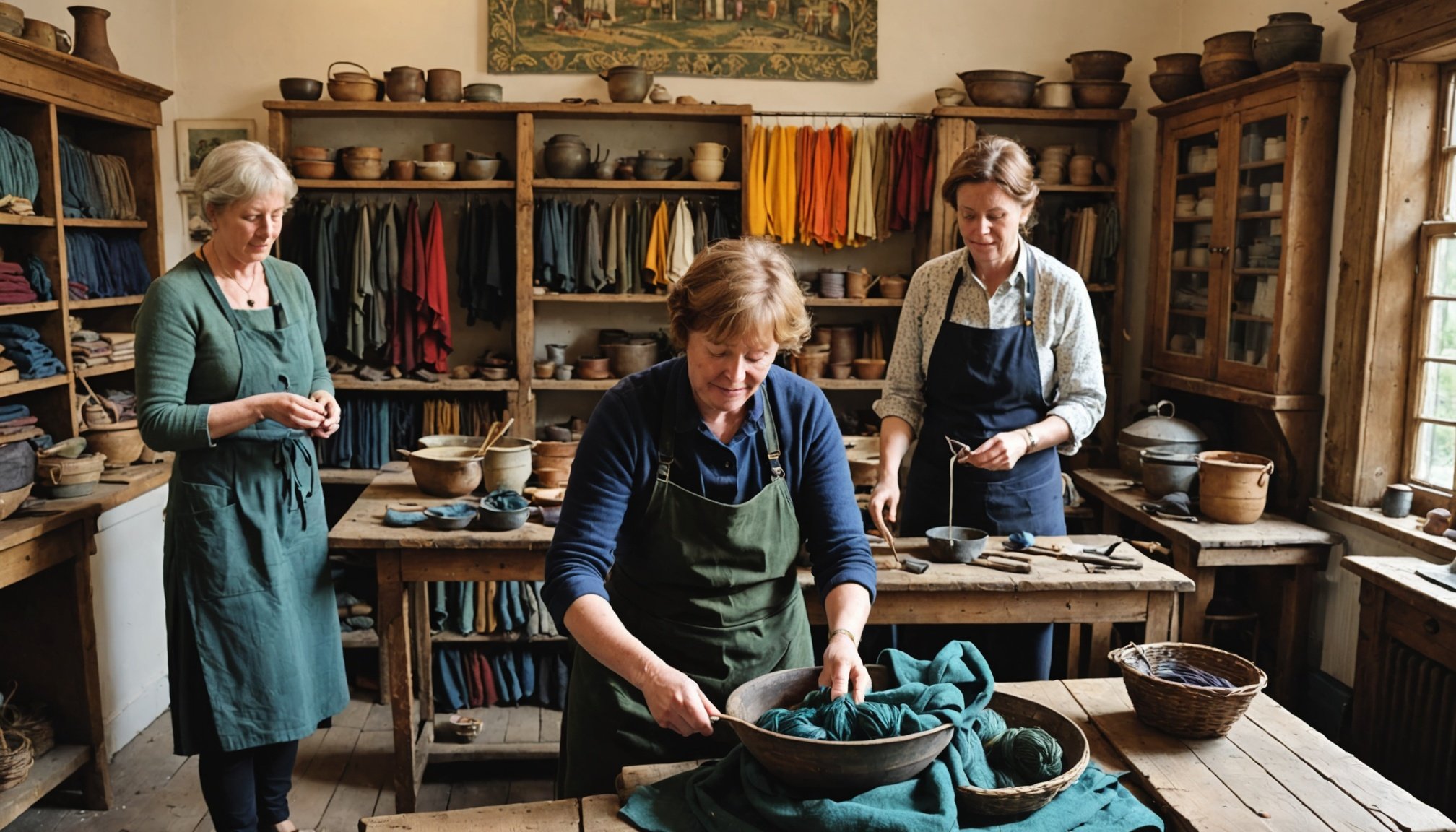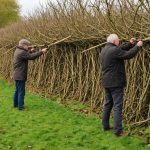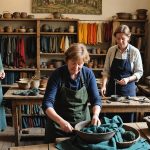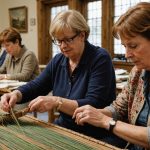Overview of Traditional British Textile Dyeing
Traditional British textile dyeing played a pivotal role in the cultural and economic fabric of Britain. With a rich historical background, it represents a craft that dates back centuries, intertwining with the economic and social dynamics of the time. The historical significance of this practice is evident, as dyeing was not only a means of personal expression but also a substantial contributor to trade and industry.
In the cultural context, textile dyeing was more than just an artistic endeavour; it underscored societal status and regional identities. Different regions favoured specific colours and techniques, reflecting local resources and traditions. This craft, often passed down through generations, highlights the ingenuity and adaptability of artisans.
Also to see : Discover the Top UK Destinations for Expert Workshops in Traditional British Tapestry Weaving
Common materials used in traditional British dyeing included natural sources such as woad, madder, and weld, which were valued for their vibrant hues and availability. Techniques varied from simple dipping and simmering to more complex processes involving multiple dye baths and mordants, which helped fix the colour to the fabric.
In sum, traditional British textile dyeing was an intricate and culturally significant practice that not only coloured fabric but also enriched British cultural heritage and identity.
Also to see : Top UK Museums Showcasing In-Depth Exhibits on British Espionage History
Immersive Workshops Available for Tourists
Diving into the vibrant world of textile dyeing workshops offers tourists an unforgettable experience. Across the UK, these workshops are designed to be both educational and engaging, providing hands-on experiences that allow participants to fully immerse themselves in the craft.
During these workshops, attendees can expect to learn about various dyeing techniques, ranging from traditional methods to modern innovations. Participants often have the opportunity to create their own textiles, enjoying the satisfaction of crafting something unique. This not only makes for a rich educational experience but also a practical one, as individuals take home their self-made masterpieces.
Tourist activities such as these provide an excellent way to understand local culture and craftsmanship. Notably, the benefits of participating in these hands-on dyeing activities extend beyond just creativity. They encourage mindfulness and focus, as the process requires patience and precision. Moreover, these workshops often foster a sense of community, where visitors can connect with locals and fellow travellers.
By engaging in a textile dyeing workshop, tourists can expect a thoroughly enriching experience, combining arts, history, and personal achievement in an enjoyable, interactive environment. This is an ideal activity for anyone looking to explore a new dimension of tourism in the UK.
Traditional Dyeing Techniques Explored
Exploring natural dyeing methods reveals an age-old craft, rooted in the use of dye plants to create vivid colours. These plants, such as indigo and madder, provide a sustainable source of colour and are central to textile artisanship. Each plant imparts unique hues, influenced by time and temperature.
Among the notable techniques in textile dyeing is shibori, a Japanese method involving intricate folding and binding to produce patterns. Batik, originating from Indonesia, uses wax-resistant dyeing to create striking designs. Understanding these techniques enriches the practice of dyeing and empowers learners to innovate.
Contrast between traditional and modern dyeing practices highlights the emphasis on craftsmanship and environmental awareness in the former. Traditional methods often require patience and skill, yet the results are distinctive and environmentally friendly. In contrast, modern dyeing tends to prioritise speed and uniformity.
Knowledge of these traditional dyeing techniques not only preserves cultural heritage but also encourages responsible textile production. Aspiring artisans participating in workshops can discover an array of possibilities offered by nature’s palette, blending historical methods with contemporary creativity.
Key Locations for Textile Dyeing Workshops
Renowned Workshops in England
England is home to numerous renowned dyeing workshop locations that attract textile enthusiasts from around the world. Predominantly found in major UK textile centers, these workshops offer a wealth of experience in traditional and contemporary dyeing techniques. London and Manchester are two popular travel destinations for these workshops, each boasting its unique styles and resources.
In London, the focus is often on innovative dyeing practices, combining art with high fashion. The workshops here provide an avenue for exploring the cutting-edge of textile design, making them ideal for tourists with an interest in haute couture.
Manchester, historically a textile powerhouse, offers workshops that celebrate its rich industrial past. Here, one can find workshops steeped in heritage, with an emphasis on wool and cotton dyeing techniques. These workshops are perfect for visitors eager to delve into the history of British textiles.
For those interested in exploring beyond the classroom, many workshops also offer tours of local cultural sites, blending education with leisure. This rich variety ensures that textile enthusiasts find England a versatile and engaging travel destination for discovering the world of dyeing.
Expert Testimonials and Insights
In the world of textile dyeing, personal experiences often provide invaluable insights. Workshop participants frequently share stories of their creative journeys. These testimonials illuminate the transformative power of hands-on learning. They reveal how, through experimentation, enthusiasts refine their skills and deepen their appreciation for the craft.
When it comes to expert insights, renowned dyeing instructors stand out as key contributors. They offer practical tips on how to achieve vibrant colours and consistent results. These experts often emphasise the importance of selecting quality materials and understanding the nuances of different dyeing techniques. Their knowledge guides both novices and seasoned practitioners in honing their craft further.
The dyeing community is a cornerstone of this creative pursuit. It fosters collaboration and support, allowing individuals to exchange ideas and solve challenges collectively. Engaging with this community not only enhances technical knowledge but also nurtures a sense of belonging. In the dyeing community, the shared purpose of pushing artistic boundaries creates strong bonds among its members.
Together, these testimonials and expert insights underscore the significance of community, illuminating how collaboration and shared knowledge drive innovation in textile dyeing practices.
Tips for Tourists Engaging in Textile Dyeing
Textile dyeing workshops offer tourists a unique opportunity to immerse themselves in local culture. Proper preparation is key for an enriching experience.
Before attending a dyeing workshop, ensure you have the essential items packed. Comfortable and old clothing is a wise choice, given the potential for spills and stains. It’s also advisable to bring an apron or overalls for added protection. The following items are also suggested:
- A notebook and pen for jotting down techniques and insights.
- Rubber gloves to protect your hands from staining.
- A face mask to avoid inhaling any pigment powders.
Adequate preparation extends beyond packing. Research the workshop’s techniques and materials in advance to gain a preliminary understanding. Familiarising yourself with terms and methods enhances your ability to engage meaningfully with the instructor and other participants.
To truly maximize the learning experience, remain curious and proactive. Don’t hesitate to ask questions about processes and materials. Engaging fully will ensure you leave with both memorable experiences and practical insights. Establish connections with other attendees to share tips and learn from their experiences, making your participation more rewarding.









